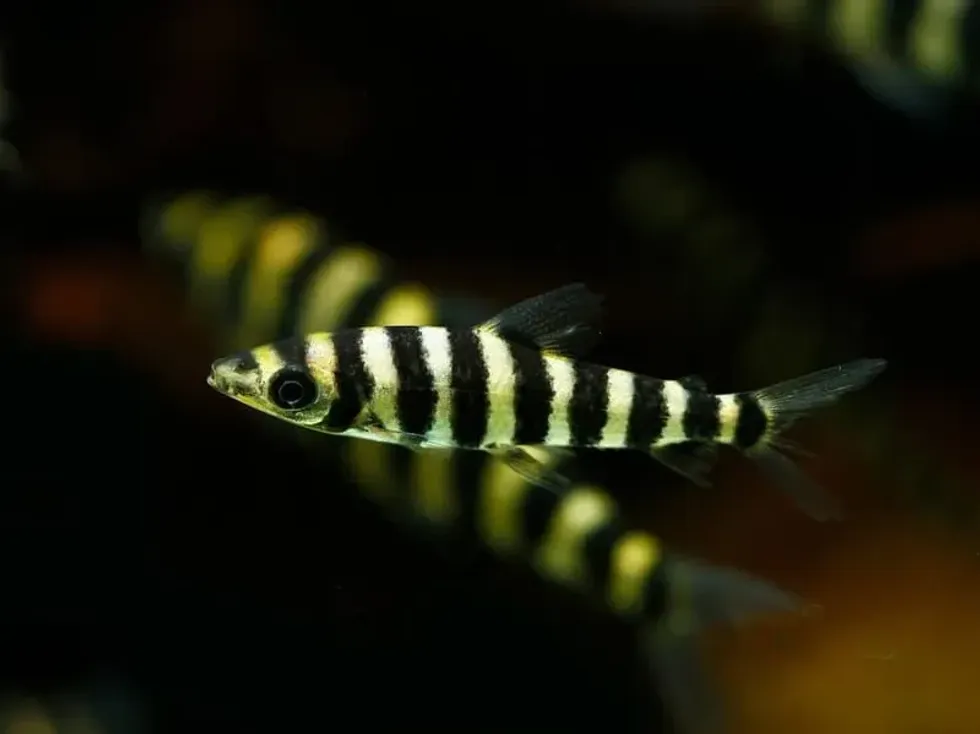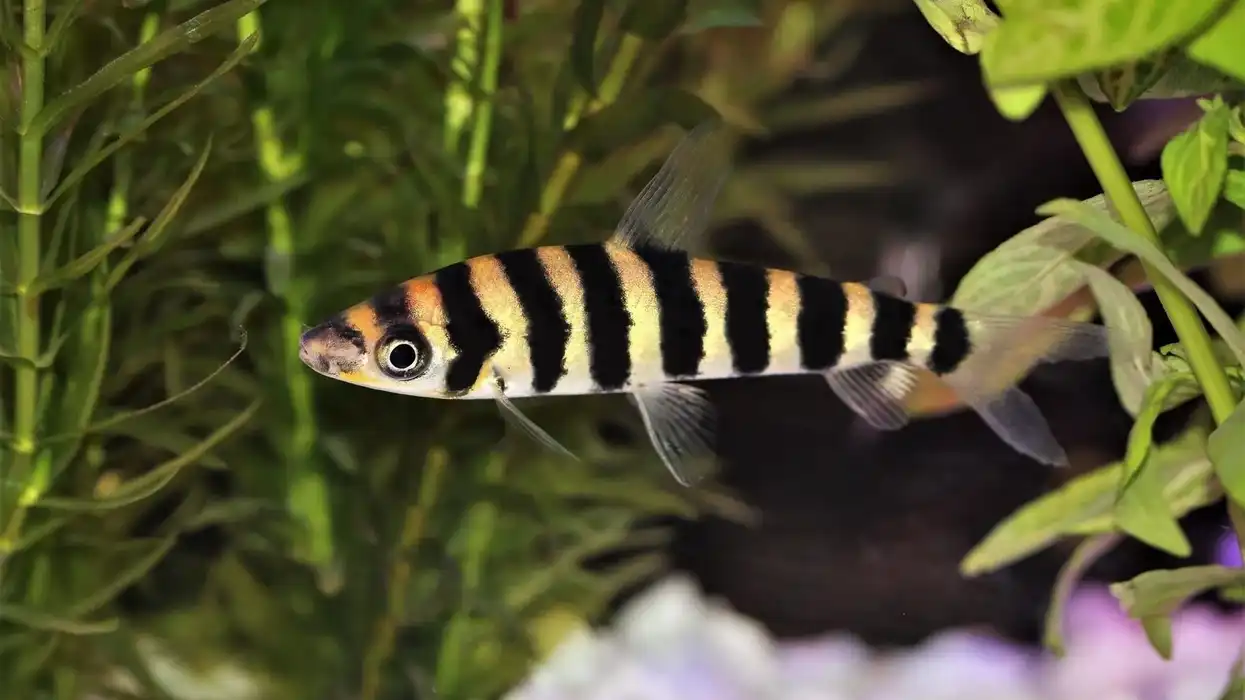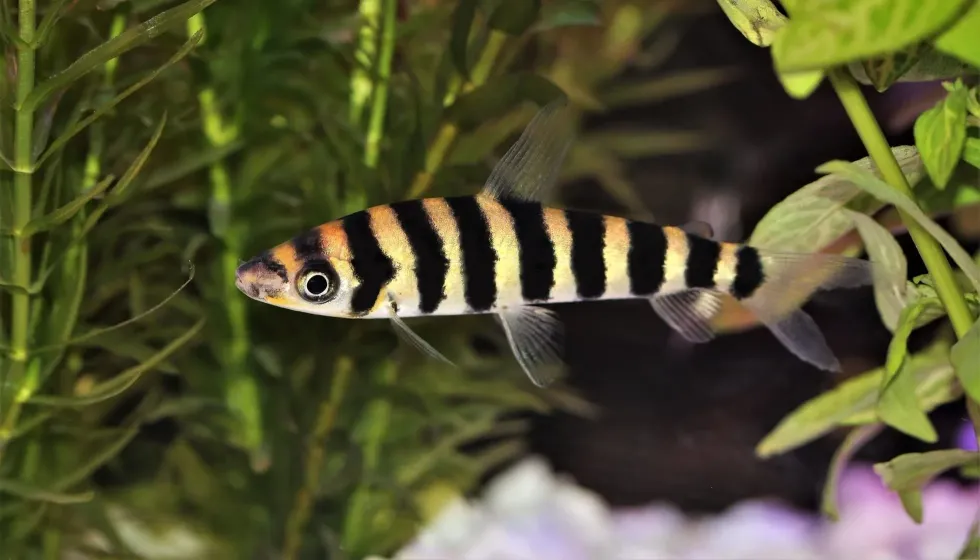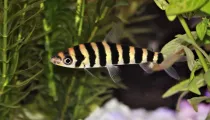Fun Black Banded Leporinus Facts For Kids

The black-banded leporinus (scientific name Leporinus fasciatus), also known as banded leporinus, is a characin species of the Anostomidae family. A native to the Amazon river in South America, these species were introduced into the waters of the United States in Hawaii and Florida. All the fish species of the Leporinus species are endemic to South American.
Currently, there are 78 officially recognized species in this genus. Several pieces of evidence link the family Anostomidae to the Paleogene period.
Currently, there are 150 described species in this family. The family is also called anostomids, which is a derivation of Ancient Greek origin words, 'ano' meaning 'up' and 'stoma' meaning 'mouth.' This refers to their 'mouth on top' arrangement.
The family is traditionally defined as monotypic. The black-banded leporinus has yellow and black bands on the body, almost similar to tiger stripes.
They are a popular species in aquarium trading, although not great for beginners. The population status of this fish has not been evaluated by IUCN. Currently, they are not under any threat due to overfishing.
If the facts about black-banded leporinus fish are helpful for you, you need to learn more about the green sunfish and mutton snapper too!
Black-Banded Leporinus Interesting Facts
What type of animal is a black-banded leporinus?
The black-banded leporinus (Leporinus fasciatus) is a fish species of the order Characiformes and phylum Chordata. They are semi-aggressive species and are active. This fish species is gregarious in its wild habitat like all the other species of Anostomidae. It does well in community aquariums.
It can be housed in aquariums with bigger species like cichlids, but will pick on smaller fishes. These fish are also referred to as banded headmasters as they position themselves with head down position in services. They are also hardy, good jumpers.
What class of animal does a black-banded leporinus belong to?
The black-banded leporinus (Leporinus fasciatus) belongs to the Actinopteriigy class of animals.
How many black-banded leporinus are there in the world?
The data on the population of the black-banded leporinus (Leporinus fasciatus) is not known.
Where does a black-banded leporinus live?
The range of habitat of the black-banded leporinus (Leporinus fasciatus) extends to Central and South America and the United States. They occupy the Amazon river basin, Venezuela, Florida, and Hawaii. However, as of the year 2005, their population in Hawaii has been extirpated.
What is a black-banded leporinus's habitat?
This striped fish is a freshwater middle dwelling species with a water temperature of around 75.2°F (24°C). The range of habitat covered by the black-banded leporinus (Leporinus fasciatus) includes flooded forests, rocky streams, and freshwater rivers. By placing a smooth at the bottom of their aquarium, you can produce a stream or a river environment.
Who does black-banded leporinus live with?
The black-banded leporinus (Leporinus fasciatus) lives in schools or in pairs.
How long does a black-banded leporinus live?
The lifespan of a black-banded leporinus (Leporinus fasciatus) is around 7-10 years in captivity.
How do they reproduce?
There is very little information on breeding in the wild and in captivity. These species rarely breed in captivity.
There is little documented proof of these striped fish species bred in captivity. The fish species reach maturity when they are around 5.9 in (15 cm) in length. Black-banded leporinus (Leporinus fasciatus) breeding takes place near water-logged groves, and when they are ready to breed, they build nests.
The females of this fish lay the eggs, and males fertilize them until the eggs hatch. The ease of breeding this fish species is also unknown.
What is their conservation status?
The conservation status of Leporinus fasciatus has not yet been evaluated by the IUCN. This fish is not under any threat due to overfishing.
Black-Banded Leporinus Fun Facts
What do black-banded leporinus look like?
The Leporinus fasciatus is a hardy fish. As juveniles, this fish has only five black bands.
The fish has yellow and black bands, and one band splits once a year, showing golden-yellow or mustard color in between. The tail fin and head often have orange markings. The fish has an elongated and torpedo-shaped body with an arched back and thin tail.
The fish has a transparent fin, and the body color varies from beige to bright yellow. The caudal fins are pointed with ten vertical stripes. The number of vertical bands on the body is 8-12.
On their throat, this fish species have a dusty red color. They have a dark-spotted nose, and the first band runs across the eyes.
Leporinus is of French origin, which means 'little hare,' referring to their front teeth. They develop rabbit or hare-like front teeth, which allow them to crush shells.
The only other species with stripes similar to this fish is Leporinus affinis. The main difference between these fishes is the number of bands and shape of the tail or caudal fins. The females and males do not differ in physical characteristics.

How cute are they?
The Leporinus fasciatus is considered an eye-catching species but not cute.
How do they communicate?
Like all other fish species, the Leporinus fasciatus also communicates through visualization, vibrations, and chemical release.
How big is a black-banded leporinus?
The Leporinus fasciatus grows up to a size of 12 in (30 cm) in length. Females are larger in size and length than males. However, their relative fish, Leporinus affinis grow only up to 9.45 in (24 cm).
How fast can a black-banded leporinus swim?
The Leporinus fasciatus is a gregarious fast swimmer in the wild. However, the exact speed of this fish is not yet known.
How much does a black-banded leporinus weigh?
The weight of Leporinus fasciatus is not readily available. However, this fish weighs around 0.9 lb (0.4 kg), as per one of the few records.
What are the male and female names of the species?
There is no specific name given to the male and the female Leporinus fasciatus.
What would you call a baby black-banded leporinus?
There is no specific name given to the baby Leporinus fasciatus. It is usually referred to as juvenile or young one.
What do they eat?
This fish mostly eats plant food, larvae, and algae. So, this fish is an omnivore. They eat whatever you feed them. Keep them healthy by feeding them snails, plants or vegetative matter, fruits, and vegetable flakes.
Other vegetable sources like cooked peas, lettuce, chickweed, and watercress. This fish also eats crustaceans, pellets, wafers, and worms. This fish becomes territorial while feeding.
Are they dangerous?
The black-banded leporinus fish is not dangerous to human beings. However, they are semi-aggressive and might attack smaller fish if they are kept together as tank mates.
Would they make a good pet?
Yes, they are popular aquarium fish species. Black-banded leporinus care is difficult and needs adequate water temperature and a balanced diet to thrive in an aquarium environment.
The minimum tank size for this fish is 70 gal (264.9 l) and temperature around 71.6-78.8 F (22-26°C). The pH level needs to be between 5.5-7.5 and hardness up to 20 dGH.
This fish does very well with other larger or same size rugged fish species as tank mates in a community tank. If there are smaller fish in the community tank, this fish feeds on them or nips their fins.
Some good large tank mates for this fish are ghost knifefish, Loricariids, characins, and Doradids. The long-finned and slow-swimming angelfish is an especially bad tank mate for this fish.
For the purpose of aesthetics, you can add bogwood or driftwood to your aquarium. These fishes might uproot any plants present in the aquarium.
To stop them from jumping out of the aquarium, a lid on it and filters need the water surface. They need good quality water, so frequent water changes are a must.
Did you know...
The black-banded liporinus or Liporinus fasciatus was first described in the year 1794 by Bloch.
This striped fish is a relative of piranhas (Serrasalmidae) and tetras (Characidae).
An identical species, Leporinus affinis, has nine stripes and rounded caudal fins.
The specific name fasciatus means 'banded,' referring to the striped black and yellow body.
The black-banded leporinus is not a good choice to make if you are a beginner aquarist.
Leporinus muyscorum is a related large fish species endemic to Colombia. They were first described in 1900 by the Austrian herpetologist, zoologist, and ichthyologist Franz Steindachner.
Due to parasites, the black-banded leporinus can cause skin diseases like flukes, Nematoda, and bacterial exposure. There are a number of signs which help you to determine if your fish is sick.
In all the fishes of the Anostomidae family, there are adipose fins. The anal fin has one and nine, the dorsal fin has one and 11, and the pelvic fin has one and nine soft and hard rays.
The closest relatives of the family Anostomidae are flannel-mouthed characins (Prochilodontidae) and toothless characins (Curimatidae).
A fossil of toothless characin, Cyphocharax mosesi, was found in Brazil studied to have been alive in the Oligocene-Miocene boundary.
The adults shelter under sand holes in their habitat and also to escape predators. Some evidence proves that this fish is a food source for piranhas.
It is said that you could count the bands on these fish's bodies to know their age.
What do you feed banded leporinus?
This fish is not a picky eater, and feeding them is quite easy. However, the fish might get territorial of the food in schools in community tanks. You can include any food in this fish species diet from The black-banded leporinus diet cannot include foods with high protein.
They eat whatever you feed them. This fish mostly eats plant food, larvae, and algae. So, this fish is an omnivore.
You can also keep them healthy by feeding them snails, plants or vegetative matter, fruits, and vegetable flakes. Other vegetable sources like cooked peas, lettuce, chickweed, and watercress. This fish also eats crustaceans, pellets, wafers, and worms.
Do leporinus eat snails?
Yes, the leporinus fish eats snails. Leporinus is of French or Latin origin, consists of two elements. Lepus means 'hare' with the suffix '-inus' means 'of or pertaining to' referring to their large pair of front teeth.
This developed rabbit or hare-like front teeth allows them to crush shells. So they can easily feed on snails as snacks, and you can use snails as treats. The snails provide the fish nutritional value needed in their diet.
Here at Kidadl, we have carefully created lots of interesting family-friendly animal facts for everyone to discover! Learn more about some other fishes from our longhorn cowfish facts and kelp rockfish facts pages.
You can even occupy yourself at home by coloring on one of our free printable fish outline coloring pages.
We Want Your Photos!
More for You
See All
Bachelor of Engineering specializing in Aeronautical/Aerospace Technology, Master of Business Administration specializing in Management

Arpitha RajendraBachelor of Engineering specializing in Aeronautical/Aerospace Technology, Master of Business Administration specializing in Management
With a background in Aeronautical Engineering and practical experience in various technical areas, Arpitha is a valuable member of the Kidadl content writing team. She did her Bachelor's degree in Engineering, specializing in Aeronautical Engineering, at Nitte Meenakshi Institute of Technology in 2020. Arpitha has honed her skills through her work with leading companies in Bangalore, where she contributed to several noteworthy projects, including the development of high-performance aircraft using morphing technology and the analysis of crack propagation using Abaqus XFEM.
Bachelor of Arts specializing in English Literature, Masters of Art specializing in English and Communication Skills

Sonali RawatBachelor of Arts specializing in English Literature, Masters of Art specializing in English and Communication Skills
Sonali has a Bachelor's degree in English literature from Guru Gobind Singh Indraprastha University and is currently pursuing a Master's in English and Communication from Christ University. With considerable experience in writing about lifestyle topics, including travel and health, she has a passion for Japanese culture, especially fashion, and anime, and has written on the subject before. Sonali has event managed a creative-writing festival and coordinated a student magazine at her university. Her favorite authors are Toni Morrison and Anita Desai.
Disclaimer
1) Kidadl is independent and to make our service free to you the reader we are supported by advertising. We hope you love our recommendations for products and services! What we suggest is selected independently by the Kidadl team. If you purchase using the Buy Now button we may earn a small commission. This does not influence our choices. Prices are correct and items are available at the time the article was published but we cannot guarantee that on the time of reading. Please note that Kidadl is a participant in the Amazon Services LLC Associates Program, an affiliate advertising program designed to provide a means for sites to earn advertising fees by advertising and linking to Amazon. We also link to other websites, but are not responsible for their content.
2) At Kidadl, we strive to recommend the very best activities and events. We will always aim to give you accurate information at the date of publication - however, information does change, so it’s important you do your own research, double-check and make the decision that is right for your family. We recognise that not all activities and ideas are appropriate for all children and families or in all circumstances. Our recommended activities are based on age but these are a guide. We recommend that these ideas are used as inspiration, that ideas are undertaken with appropriate adult supervision, and that each adult uses their own discretion and knowledge of their children to consider the safety and suitability. Kidadl cannot accept liability for the execution of these ideas, and parental supervision is advised at all times, as safety is paramount. Anyone using the information provided by Kidadl does so at their own risk and we can not accept liability if things go wrong.
3) Because we are an educational resource, we have quotes and facts about a range of historical and modern figures. We do not endorse the actions of or rhetoric of all the people included in these collections, but we think they are important for growing minds to learn about under the guidance of parents or guardians.







